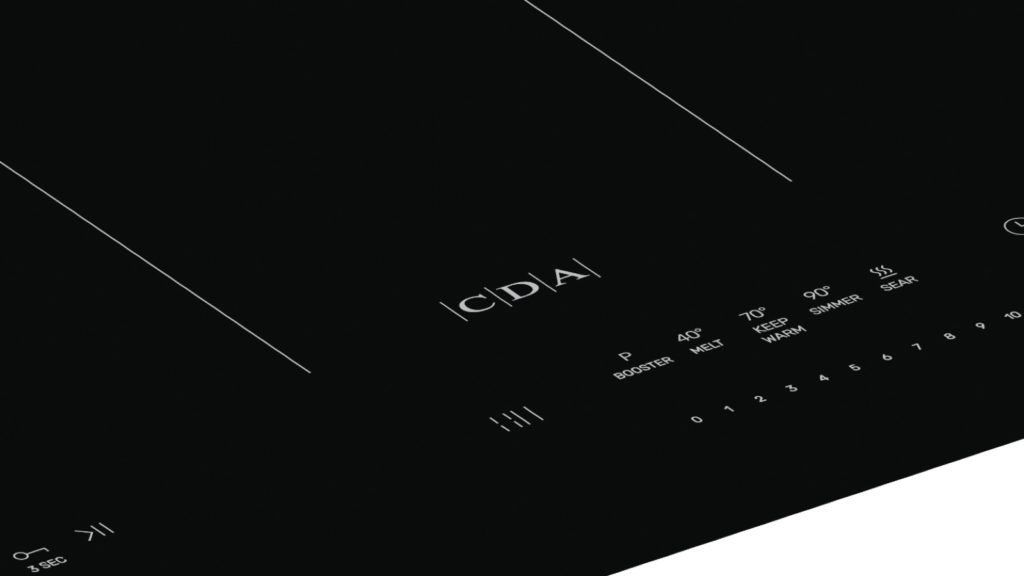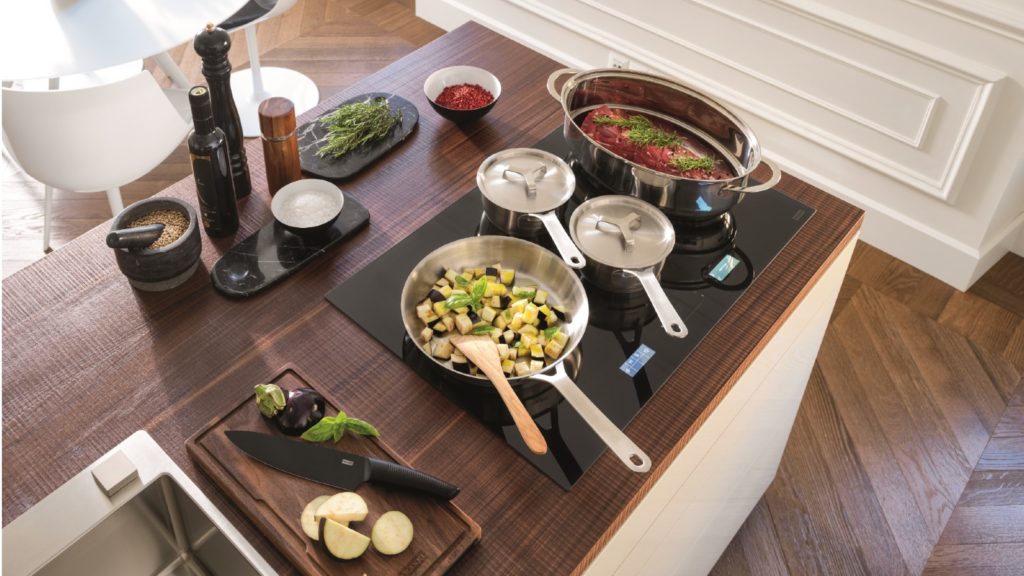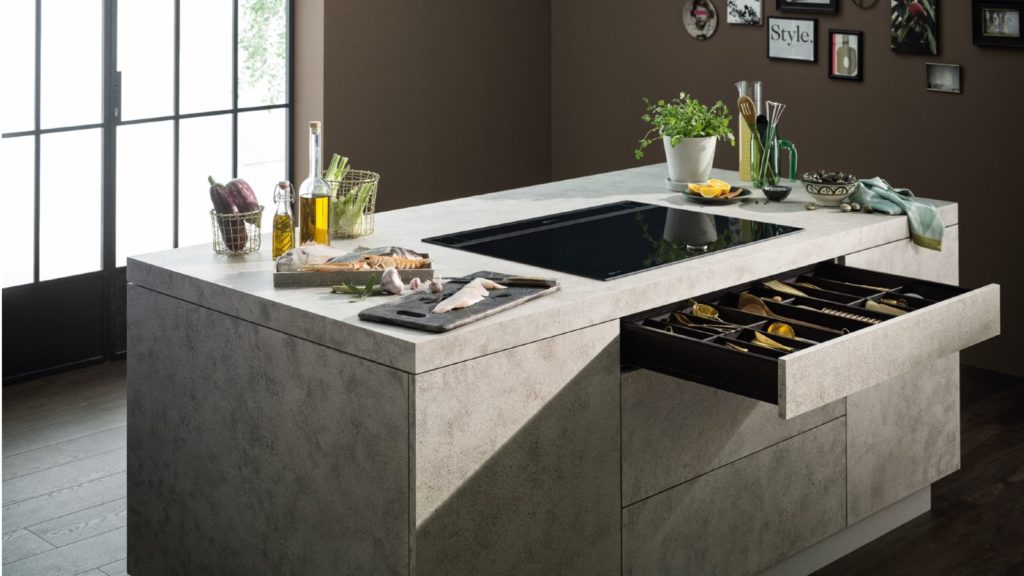Induction hobs | Ringside seat
Vented induction hobs have taken the market by storm, but does that mean consumers unable to have one are limited for cooking tech? Spoiler alert: No.
Vented induction hobs have taken the market by storm, but does that mean consumers unable to have one are limited for cooking tech? Spoiler alert: No.

Asko Celsius°Cooking Induction Hob (HID956MC) can be used with Bluetooth connected pot, pan and probe, so consumers can cook food to precise temperatures and control timings.
While vented induction hobs are fast becoming a must-have for most up-to-date kitchen schemes, they’re not suitable for all projects.
They can be more expensive, take up cupboard space for the ducting, if installed in a run of units, and can’t be fitted above a full-size built-under oven, due to the space required for motor and fan.
Sponsored Video
Vented induction can also limit the size of the cooking surface, with the integral downdraft extractor taking up zone space.
However, with a growing interest which has seen induction hob sales double in eight years, according to Miele, designers can still meet consumer demand with a variety of models boasting top-end tech.
Induction advantages
Consumers have realised the advantages of induction, that it is safer and more energy efficient and easier to keep clean than their gas hob counterparts.

The HN6860FR induction hob from CDA features HObConnect which allows it to communicate with CDA’s CH60BL extractor to ensure the correct level of ventilation.
Induction is only operated when the pan is on the hob, is as responsive as gas but takes less time to cook using less energy, and has a wipe-clean surface.
However, it is the myriad of cooking functions attracting the attention of buyers.
Sales and marketing director at Franke Jo Sargent comments: “The great thing about induction hobs it that they pack in so many features and benefits that belie their minimalist looks, including power boost, precision temperature control, pan detection, automatic shut-off, timers and flexible cooking zones which, when understood and used correctly, give the user a lot of satisfaction and convenience as standard.”
Surface space
But what is the tech consumers are looking for in an induction?

Franke Mythos Induction hob measures boasts eight cooking zones, FlexPro zone for cooking on a fully flexible surface and Cook Assist mode
Assistant product manager of surface cooking at BSH Home Appliances Sangharsha Karki points out: “One of the most significant advantages of induction hobs is their flexibility in terms of cooking zones, which appeals to both amateur and professional chef alike.”
It means consumers can choose from bridging zones, to cater for larger pans and fish kettles, through to full surface cooking where the hob detects the size and position of the cookware and heats the appropriate area.
Such is the popularity, Beko reports 40% of its induction hob sales boast a bridging function.
Kitchens manager at Miele GB Tom Hopper adds: “Within the Miele range, most of our models have some level of ‘powerflex zones’ (bridging) or are full surface.
“So, naturally, we are seeing more and more consumers trade into this technology.”
Convenience and control
Greater convenience is also offered in the variety of cooking functions with Power Boost still a popular feature, providing higher temperatures and so reducing cooking time.

Neff induction hob features TwistPadFire, a magnetic and removeable dial, which controls the Flex Induction bridging technology and power tracking. In addition it features HomeConnect which offers hob-based hood operation.
But industry experts say retailers shouldn’t just focus on the most obvious tech and look to precise and automated temperature control.
Sangharsha Karki of BSH Home Appliances states: “Retailers often focus on the most popular features when selling their products, but there are many other features that could be just as effective in driving sales, such as Perfect Cook which allows the hob to control the temperature of what’s cooking or boiling over.”
Whereas, Asko offers Celsius°Cooking with 11 power levels and Bluetooth connected pot, pan and probe.
It uses sensor technology to allows consumers to cook food precisely, and deliver the same results without the need for supervision.
Whereas Franke offers the Cook Assist function, with three levels of help from Easy Cook to Pro Cook, to guide consumers through the cooking process.
However, Jo Sargent at Franke believes it’s underpromoted because it needs in-store demonstration, adding the technology “has something to offer people of all abilities by offering convenience and guidance that will help maximise the quality of food.”
Connectivity and customisation
It will be the advancement of technology which will see the greater adoption of smarter technologies to ease use.

With full surface induction and DiamondFinish design for scratch resistance Miele has introduced the KM7897 FL Diamond Induction Hob with Con@ctivity to communicate with a compatible Miele cooker hood
“A real consumer benefit is connectivity; such as a wireless connection between the induction hob and cooker hood.
“It enables air throughput to be increased or decreased depending on the hob setting, which means not only a better performance but also energy saving for the customer”, explains Tom Hopper of Miele.
Reflecting this, CDA has recently launched the HoodConnect Hob with four pre-set temperatures and Bluetooth connection with complementary hood.
However, industry experts also believe customisation will play a greater role, too, with the likes of Fisher & Paykel offering induction and teppan modules in its Series 11 Modular Cooktop, as well as colour choice for individual appeal.
Induction hobs are now available with a choice of coloured glass, while the Neff Flex Design hobs offers four magnetic coloured trims which are easy to update.
When asked how the induction hob market would develop in the short-term, Jo Sargent of Franke said: “We see the induction hob market growing across all demographic because the product is such a winning combination of streamlined style and design, together with high levels of functionality.”
She concluded the induction hob was supported by an ongoing drive for energy efficiency, and added: “The coming years will see further development in smart technology, reflecting the rising popularity of smart products in everyday life.”
Related Articles
#socialwall
Sintered stone manufacturer Neolith has launched Calacatta Roma and Cappadocia Sunset, inspired by nature and classical architecture, and for use in kitchens or bathrooms walls, floors, in gardens or facades.

They belong to The New Classtone and Fusioncollections which interpret marble and natural stone, respectively, and boast Neolith’s antibacterial NeolEAT technology.
Inspired by Ancient Rome, Calacatta Roma (pictured top) pays homage to Italian Carrara marble, with ochre and grey veins in a white background.
While the Cappadocia region, in central Turkey, with its rock formations formed by volcanoes and underground cities, has inspired Cappadocia Sunset (pictured below).

Just like all of Neolith’s surfaces, Calacatta Roma and Cappadocia Sunset are resistant to heat and atmospheric conditions, are 100% recyclable, and do not contain added quartz to their formulation.
Mar 14, 2024
JUST OUT: @AcquabellaBath has unveiled a choice of shower grate patterns for its Base and Arq shower trays… https://t.co/kMN83c40Qf
JUST OUT: @FrankeUK unveils Mythos single lever mixers in Swivel Spout and Pull-out Nozzle options. #kitchendesign https://t.co/TSKCAo5r0e
INTERVIEW: Sales and marketing director of @blumuk David Sanders on how the kitchen industry has changed post-pand… https://t.co/k9LIpUhhDF
NEWS: Challenging housing market is driving home improvements, finds new research by @HafeleUK #HomeImprovement… https://t.co/eMB7jludIm
NEWS: British manufacturer @kudosshowersltd acquired by European SanSwiss. #acquisition #manufacturers #bathrooms https://t.co/gpOv7jMevn
NEWS: @HafeleUK announces Richard Curtis as managing director. #newhire #appointment #leadership https://t.co/NP8U5ramOb
NEWS: @officialbikbbi names CT1 sealant manufacturer as corporate sponsor. #installation #installer https://t.co/8zsxs2HI3n
NEWS: @quookeruk named one of fastest-growing companies in North West. #business #Awards https://t.co/9zZ1ZDGrFI
RETAILER FOCUS: Managing director and design director of UK Kitchen Retailer of the Year @KitchensbyJSG Jim Geddes… https://t.co/JhL3vmxwbd
NEWS: Consumers are renovating for long term, with kitchens and bathrooms a priority, finds @HouzzUK… https://t.co/9VhoTUDI0B
PROFILE: Managing Director of Flair Showers Alan Wright talks about the relaunch of the company, creation of a Show… https://t.co/WDMPqDt2Uk
The new @blumuk carbon black LEGRABOX boasts beautifully slim drawer sides, bringing furniture onto trend, easily b… https://t.co/DrEXXWTyQb
NEWS: House of Fraser owner @FrasersGroupPLC enters strategic partnership with @ao, buying a stake in the online e… https://t.co/44N0O9bekn
NEWS: @HowdensJoinery awarded @WhichUK Best Buy for its rigid cabinets and handleless kitchens. #kitchen… https://t.co/rALz8XRHbv
NEWS: @grohe invites 800 guests from around the world to its Grohe X Professional event in Lisbon, Portugal.… https://t.co/2RGjDum980
JUST OUT: Home appliance brand Candy has unveiled the Rapido dishwasher, claimed to be the fastest and most spaciou… https://t.co/mbWn2pJp2C
Newsletter
Sign up to receive our newsletter and we’ll send you details of our latest videos, competitions and much more

